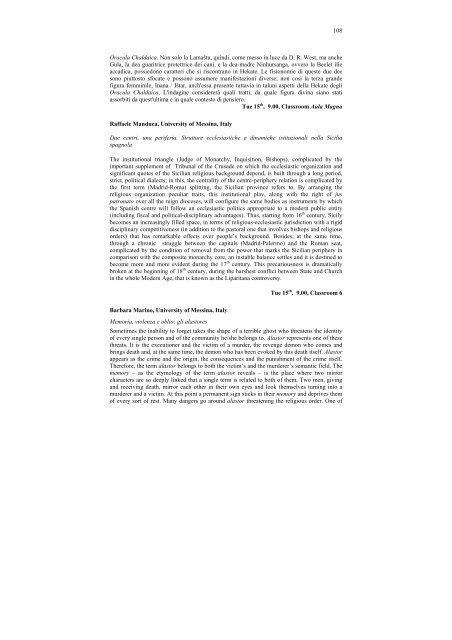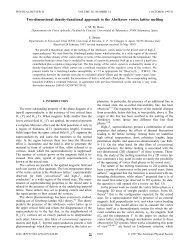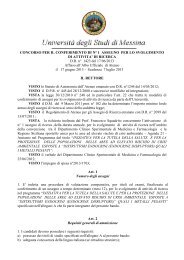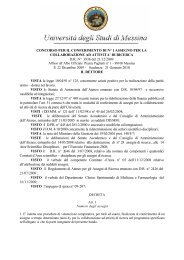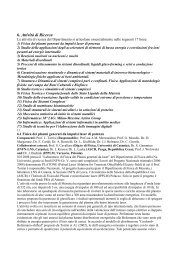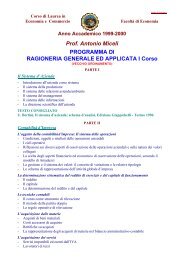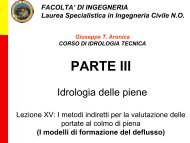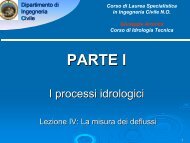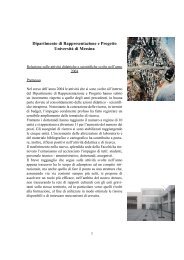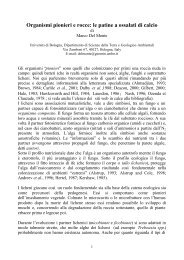PROGRAMME AND ABSTRACTS - Università degli Studi di Messina
PROGRAMME AND ABSTRACTS - Università degli Studi di Messina
PROGRAMME AND ABSTRACTS - Università degli Studi di Messina
You also want an ePaper? Increase the reach of your titles
YUMPU automatically turns print PDFs into web optimized ePapers that Google loves.
108<br />
Oracula Chaldaica. Non solo la Lamaštu, quin<strong>di</strong>, come messo in luce da D. R. West, ma anche<br />
Gula, la dea guaritrice protettrice dei cani, e la dea-madre Ninhursanga, ovvero la Beelet ilie<br />
acca<strong>di</strong>ca, possiedono caratteri che si riscontrano in Hekate. Le fisionomie <strong>di</strong> queste due dee<br />
sono piuttosto sfocate e possono assumere manifestazioni <strong>di</strong>verse; non così la terza grande<br />
figura femminile, Inana / Ištar, anch'essa presente tuttavia in taluni aspetti della Hekate <strong>degli</strong><br />
Oracula Chaldaica. L'indagine considererà quali tratti, da quale figura <strong>di</strong>vina siano stati<br />
assorbiti da quest'ultima e in quale contesto <strong>di</strong> pensiero.<br />
Tue 15 th , 9.00, Classroom Aula Magna<br />
Raffaele Manduca, University of <strong>Messina</strong>, Italy<br />
Due centri, una periferia. Strutture ecclesiastiche e <strong>di</strong>namiche istituzionali nella Sicilia<br />
spagnola<br />
The institutional triangle (Judge of Monarchy, Inquisition, Bishops), complicated by the<br />
important supplement of Tribunal of the Crusade on which the ecclesiastic organization and<br />
significant quotes of the Sicilian religious background depend, is built through a long period,<br />
strict, political <strong>di</strong>alects; in this, the centrality of the centre-periphery relation is complicated by<br />
the first term (Madrid-Roma) splitting, the Sicilian province refers to. By arranging the<br />
religious organization peculiar traits, this institutional play, along with the right of jus<br />
patronato over all the reign <strong>di</strong>oceses, will configure the same bo<strong>di</strong>es as instruments by which<br />
the Spanish centre will follow an ecclesiastic politics appropriate to a modern public entity<br />
(inclu<strong>di</strong>ng fiscal and political-<strong>di</strong>sciplinary advantages). Thus, starting from 16 th century, Sicily<br />
becomes an increasingly filled space, in terms of religious-ecclesiastic juris<strong>di</strong>ction with a rigid<br />
<strong>di</strong>sciplinary competitiveness (in ad<strong>di</strong>tion to the pastoral one that involves bishops and religious<br />
orders) that has remarkable effects over people’s background. Besides, at the same time,<br />
through a chronic struggle between the capitals (Madrid-Palermo) and the Roman seat,<br />
complicated by the con<strong>di</strong>tion of removal from the power that marks the Sicilian periphery in<br />
comparison with the composite monarchy core, an instable balance settles and it is destined to<br />
become more and more evident during the 17 th century. This precariousness is dramatically<br />
broken at the beginning of 18 th century, during the harshest conflict between State and Church<br />
in the whole Modern Age, that is known as the Liparitana controversy.<br />
Barbara Marino, University of <strong>Messina</strong>, Italy<br />
Memoria, violenza e oblio: gli alastores<br />
Tue 15 th , 9.00, Classroom 6<br />
Sometimes the inability to forget takes the shape of a terrible ghost who threatens the identity<br />
of every single person and of the community he/she belongs to. Alastor represents one of these<br />
threats. It is the executioner and the victim of a murder, the revenge demon who comes and<br />
brings death and, at the same time, the demon who has been evoked by this death itself. Alastor<br />
appears as the crime and the origin, the consequences and the punishment of the crime itself.<br />
Therefore, the term alastor belongs to both the victim’s and the murderer’s semantic field. The<br />
memory – as the etymology of the term alastor reveals – is the place where two mirror<br />
characters are so deeply linked that a single term is related to both of them. Two men, giving<br />
and receiving death, mirror each other in their own eyes and look themselves turning into a<br />
murderer and a victim. At this point a permanent sign sticks in their memory and deprives them<br />
of every sort of rest. Many dangers go around alastor threatening the religious order. One of


